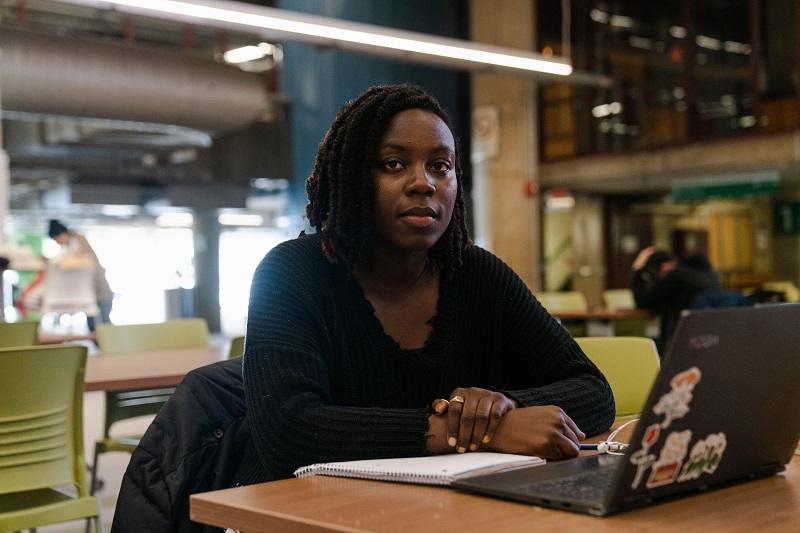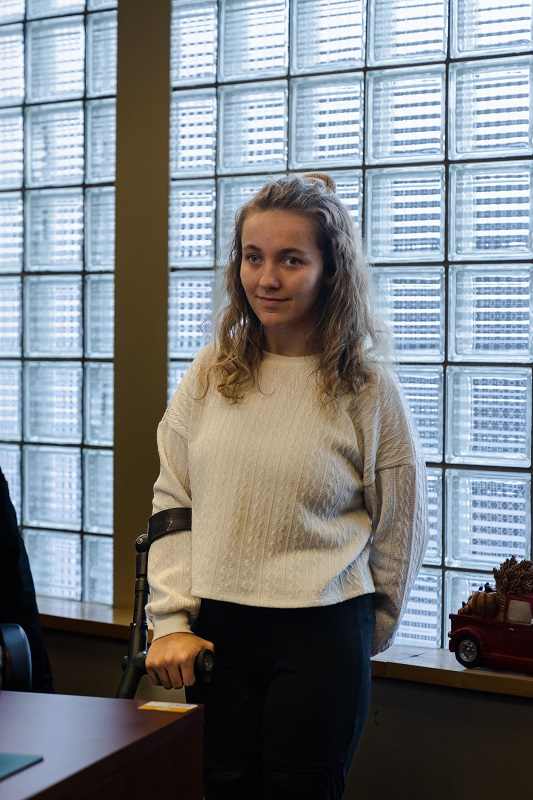
Anne-Marie Jean-Louis, 26, a Navy veteran starting her education at the Community College of Rhode Island (CCRI), hopes to transfer and get a bachelor’s and eventually a graduate degree in neuroscience.
15:01 JST, January 7, 2023
WARWICK, R.I. – Anne-Marie Jean-Louis is just getting started toward her bachelor’s degree in biology with the goal of eventually getting a graduate degree in neuroscience.
That’s a long slog in the best of circumstances. And Jean-Louis is starting out at a community college with plans to transfer to a four-year university, making the process likely to take even longer.
On paper, starting at a community college is a great idea. Community colleges typically have open admission and are comparatively cheap or even free. Four in five students who begin their higher education at a community college say they plan to transfer and eventually earn a bachelor’s degree or higher.
But in one of the most persistent failings of the higher education system, only about 1 in six of them succeed – and even fewer than that at the Community College of Rhode Island, which Jean-Louis attends.
They get lost in a process for which colleges and universities often offer little guidance, causing students to waste time and money earning credits that do not count toward bachelor’s degrees. That not only thwarts the aspirations of students and their families, but it also adds costs for the state and federal taxpayers who subsidize their educations.
And new figures show that rather than improving, the problem has been getting worse.
The already low proportion of students transferring from community colleges to bachelor’s degree-granting universities fell by about 10 percent over the past two years, according to the National Student Clearinghouse Research Center. The decline is even bigger for Black students (14 percent) and men (12 percent).
“We screw transfer students, and we especially screw the ones that don’t have access to the social and educational capital they need to navigate” the process, said John Fink, senior research associate at the Community College Research Center at Teachers College, Columbia University, who studies the transfer process. (The Hechinger Report, which produced this story, is an independent unit of Teachers College.)
The transfer decline is in part a result of the big drop in the number of people going to college at all, leaving fewer of them to move from one campus to another. Enrollment at community colleges has taken a particular hit, declining 5.4 percent in the past two years.
But that explains only about half the problem. Experts also cite intensifying public skepticism about the value of a degree and the cost of getting one, which has soured many people on the idea of higher education – and community college students on the prospect of going further.
Another major culprit is a system that’s extremely tough to navigate and for which students get little help. Transfer students continue to “face an uphill battle as they contend with unclear information and insufficient guidance on this complex process,” a new report by the higher education consulting firm HCM Strategists says. “Such dismal outcomes and rife inefficiency should be a wake-up call to us all.”
Jean-Louis spends much of her free time emailing department chairs at universities to which she’d like to transfer, checking to make sure she is taking the right courses. “I don’t want to waste my time,” she said as she prepared for finals, bent over graph paper in the high-ceilinged Community College of Rhode Island cafeteria.
Even when a four-year university accepts community college credits, those credits may not apply to the student’s intended major.
“I’ll be honest: The process is difficult,” Jean-Louis, a 26-year-old Navy veteran, said. “It is confusing. If I didn’t have this goal, it would be very hard.”
None of these problems are new. But despite more than a decade of calls for improvement, myriad barriers remain.
Progress “has been kind of stuck,” Fink said. “Then you’re laying the pandemic on top of this, and it’s just moving in the wrong direction.”
The Community College of Rhode Island, or CCRI, is part of a new coalition of 32 community colleges and 32 four-year universities nationwide trying to find new ways to clear the transfer minefield. These institutions will be testing solutions to the problem in a two-year project led by the Aspen Institute College Excellence Program.
CCRI has hired a full-time transfer coordinator and started a program called the Joint Admissions Agreement under which its students are conditionally guaranteed eventual admission to the public Rhode Island College or the University of Rhode Island (URI), with a sliding scale of tuition discounts based on their grade-point averages. CCRI already offers free tuition for two years for Rhode Islanders who enroll right after high school and maintain a certain GPA.
Students who participate in the joint admission program are required to meet with transfer advisers each semester. They also get access to software that tracks their academic progress.
“There’s a clear path of exactly the courses you need to take and when you need to take them,” said Greg LaPointe, the college’s vice president for student affairs and its chief outcomes officer.
Last year, 136 entering students signed up, from among CCRI’s enrollment of nearly 12,000, LaPointe said. This year, after a $150,000 marketing and advertising push, 694 did.

Bryanna Lyons is a student at CCRI who has signed up for a program to help her transfer to a four-year university for a bachelor’s degree.
Bryanna Lyons, a first-year student majoring in human development and family studies, is one of them. She shook her head and laughed when asked whether she could figure out the transfer process without the help of an adviser. “No,” said Lyons, who plans to go to URI and ultimately become a teacher. “It’s really hard to figure out if someone doesn’t tell you how to do it.”
Another CCRI student, Roberto Martin Catoni, always wanted to go to URI, but his grades in high school fell short. “I thought this would be a fresh start,” he said of enrolling at CCRI with the intention of transferring into URI’s computer science and electrical engineering major.
Without help from an adviser, though, “you have three different documents that are 100 pages long, and you’re going to have to look through all those 300 pages” of course catalogues to make sure the classes and credits sync up, he said. “It would take a lot more time.”
That this kind of transfer advising was not available before, said CCRI President Meghan Hughes – and is still rare at other community colleges – is “outrageous and unacceptable.”

Meghan Hughes is the president of CCRI, which is trying to improve the proportion of its students going on to get bachelor’s degrees. That the support they need was not available before, she says, is “outrageous and unacceptable.”
Students who struggle to transfer, often find “a lack of momentum, a loss of money and a sense that they’re never going to get to the top of the hill they’re climbing,” Hughes said.
When CCRI began to work on the transfer process, it found that 42 percent of its 270 general education courses weren’t accepted for credit by the state’s two public universities, said Rosemary Costigan, the vice president for academic affairs and herself a CCRI graduate. The college has since cut the number of these courses almost in half, she said, and 95 percent of the ones that are left are accepted for transfer credit by URI and Rhode Island College.
One of the problems was that the institutions hadn’t always talked to each other. “Even in this small state, we’ve encountered that,” Costigan said.
Another problem is the idea that higher education in general “is survival of the fittest,” she said. Students are often left to figure out the transfer process on their own. “If you’re a young person and the first in your family to go to college,” Costigan said, “there’s a lot of hoops you need to jump through.”
Hughes said she’s heard other higher education leaders dismiss low transfer success rates by saying that college is not for everybody. What they really mean, she said, is that college is not designed for everybody – notably, the disproportionately low-income, first-generation, Black and Hispanic students served by community colleges.
Black and Hispanic students are half as likely to transfer as White students, and lower-income students half as likely as higher-income ones, the National Student Clearinghouse Research Center reports. That contributes to the fact that only 28 percent of Black and 21 percent of Hispanic adults have bachelor’s degrees, according to the Census Bureau, in comparison with 42 percent of White adults.
And yet a bachelor’s degree is “crucial” to getting a “good job” – meaning one with a salary of at least $35,000 – the Georgetown University Center on Education and the Workforce estimates.
“What’s promising is the potential [of transfer] to reverse historical inequities in who has bachelor’s degrees in this country,” said Fink, the researcher who studies the transfer process. “But right now, it’s just replicating those inequities.”
Improving the transfer route from community colleges to four-year universities would result in 9 million more Black and nearly 8 million more Hispanic bachelor’s degree holders, the Aspen Institute estimates.
Congressman Joaquin Castro (D-Tex.) in September introduced the Transparency for Transfer Students Act, requiring transfer credit policies to be clearly disclosed on college and university websites.
Other groups have also started working on this problem, including the Scaling Partners Network, backed by the Bill & Melinda Gates Foundation, which has issued a call to action to improve the transfer process. (Gates is among the financial supporters of The Hechinger Report.)
The Gates initiative includes the American Association of Community Colleges, American Association of State Colleges and Universities, Association of Public and Land-grant Universities and other organizations whose members are among the institutions where students have long faced transfer hurdles.
Many of those institutions are now facing sharp declines in enrollment and see transfer students as much-needed tuition-paying customers.
Several four-year schools have entered into “dual-admission” agreements with community colleges to streamline transfer, admitting students to two- and four-year institutions at the same time and providing advising to help them transfer from one to another.
These agreements include the New England Transfer Guarantee, set up by the New England Board of Higher Education in Connecticut, Massachusetts and Rhode Island, which guarantees community college students conditional transfer admission to participating four-year universities. The program will next expand to Maine, New Hampshire and Vermont. Universities and colleges in the Northeast face among the nation’s most severe enrollment challenges.
In its first three semesters (two in Rhode Island, which joined later), the guarantee helped an average of about 100 students per semester transfer in Massachusetts, 40 per semester in Connecticut and eight per semester in Rhode Island, a new report shows.
Twelve Minnesota private colleges in October also launched a transfer admission guarantee for community college students.
In addition to enrollment woes, public universities in some states are facing funding pressures as legislatures tie their budget allocations not to the number of students they admit, as in the past, but to how many graduate. This, too, is helping bring attention to the transfer problem, said Connie Richardson, the manager of higher education course services at the Charles A. Dana Center at the University of Texas at Austin, one of the partners in the Gates coalition.
“Institutions are really starting to look at, ‘Where are we losing students?'” Richardson said. They’re recognizing that rejecting students’ transfer credits “is counterproductive and they can actually do better by working together.”
Back at CCRI, student Bless Bartuah is resuming his education after starting at URI, where he lost his financial aid and was forced to withdraw. Since he couldn’t pay for all his courses, he said, the university withheld his transcript, and he’s had to start again from scratch.
“This is me taking another chance on myself,” said Bartuah, who hopes eventually to transfer, get a bachelor’s degree in engineering and pursue a career in robotics.
He said he is working with advisers to be absolutely sure he takes only the courses that will transfer.
“I don’t want to be in school forever,” he said.
"News Services" POPULAR ARTICLE
-

American Playwright Jeremy O. Harris Arrested in Japan on Alleged Drug Smuggling
-

Japan’s Nikkei Stock Average as JGB Yields, Yen Rise on Rate-Hike Bets
-

Japan’s Nikkei Stock Average Licks Wounds after Selloff Sparked by BOJ Hike Bets (UPDATE 1)
-

Japanese Bond Yields Zoom, Stocks Slide as Rate Hike Looms
-

Japan’s Nikkei Stock Average Buoyed by Stable Yen; SoftBank’s Slide Caps Gains (UPDATE 1)
JN ACCESS RANKING
-

Keidanren Chairman Yoshinobu Tsutsui Visits Kashiwazaki-Kariwa Nuclear Power Plant; Inspects New Emergency Safety System
-

Imports of Rare Earths from China Facing Delays, May Be Caused by Deterioration of Japan-China Relations
-

University of Tokyo Professor Discusses Japanese Economic Security in Interview Ahead of Forum
-

Japan Pulls out of Vietnam Nuclear Project, Complicating Hanoi’s Power Plans
-

Govt Aims to Expand NISA Program Lineup, Abolish Age Restriction

























